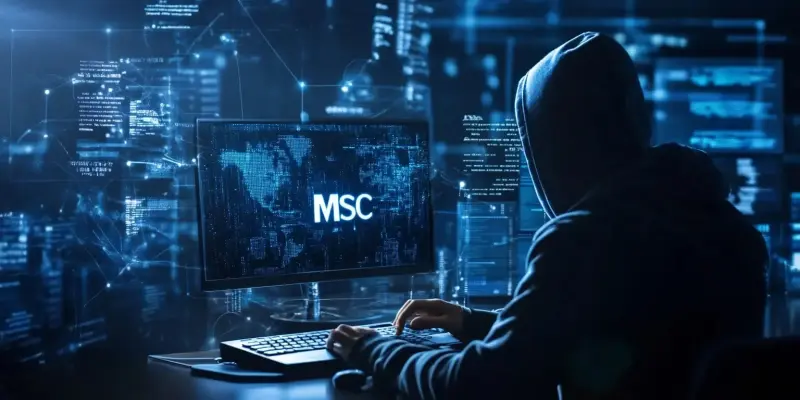A newly discovered phishing campaign, known as the FLUX#CONSOLE campaign, has taken the cybersecurity community by surprise. Unveiled by the Securonix Threat Research team, this sophisticated attack targets users through Microsoft Common Console Document (MSC) files, showcasing a departure from the traditional use of malicious LNK shortcut files to deliver stealthy backdoor payloads on Windows systems.
Phishing Tactics
The campaign begins with a tax-themed phishing email designed to lure unsuspecting victims. For instance, one of the tactics involves using decoy PDF documents named in ways that catch the recipient’s attention, such as “Income-Tax-Deduction-and-Rebates202441712.pdf.” Embedded within these PDFs are MSC files that unsuspectingly execute malicious payloads on the user’s system without their knowledge. This new method of phishing highlights the cunning and evolving strategies of cybercriminals.
MSC File Exploitation
MSC files, generally used for legitimate administrative purposes, are now being exploited due to their capability to run embedded scripts. Unlike the more traditionally used LNK files, MSC files offer a way for attackers to execute malicious actions while bypassing standard security measures. This exploitation strategy is particularly effective because MSC files appear to be part of legitimate system tools, thereby reducing suspicion and increasing the chances of successful execution.
Advanced Techniques for Evasion
The FLUX#CONSOLE campaign employs multiple sophisticated techniques to avoid detection. One notable method is obfuscation, where malicious code is encrypted or hidden, making it difficult for detection tools to recognize it as harmful. Another advanced technique used is DLL sideloading, where a malicious DLL named “DismCore.dll” is loaded using a legitimate Windows tool, “Dism.exe.” This method allows the attack to leverage trusted system processes to execute its payload. Furthermore, the campaign employs persistence mechanisms, such as creating scheduled tasks, ensuring the malware remains active even after the system reboots.
MSCs as Emerging Threat Vectors
The rise in the use of MSC files as vectors for cyber attacks presents a growing concern. Traditionally harmless and used for administrative tasks, MSC files have now become an attractive option for attackers due to their ability to execute scripts. This emerging threat underscores the need for robust security measures and vigilance against seemingly benign files that could harbor malicious intentions.
Attack Process Overview
The attack typically follows a structured process. Initially, a target receives a phishing email containing a tax-related lure. When the victim opens the attached MSC file disguised as a PDF, the embedded XML commands in the MSC file either download or extract the malicious DLL payload from a remote server or within the file itself. The payload execution is facilitated by moving “Dism.exe” to a staging directory, allowing the sideloading of the DLL. This leads to the malicious DLL executing and establishing communication with a Command-and-Control (C2) server. The attack then maintains persistence through scheduled tasks, enabling the malware to exfiltrate data to the C2 server via encrypted HTTPS traffic.
Main Findings and Implications
The FLUX#CONSOLE campaign exemplifies the ever-changing tactics employed by cybercriminals. This shift towards using lesser-known file types and leveraging legitimate tools for malicious activities is a testament to the growing sophistication of cyber attacks. The campaign specifically targeted users in Pakistan with tax-themed lures, suggesting a possible regional focus. Although it did not match known advanced persistent threat (APT) groups, the level of sophistication displayed, particularly in evading detection and maintaining persistence, signals a significant advancement in attack strategies.
The findings highlight the increasing challenge for cybersecurity professionals, emphasizing the necessity for continuously updated defense mechanisms and heightened alertness against emerging threats. This campaign serves as a reminder of the importance of staying informed about evolving cyber attack methods and adapting security practices to mitigate risks effectively.
In conclusion, the recently uncovered phishing campaign, known as the FLUX#CONSOLE campaign, has startled the cybersecurity community. This advanced attack was revealed by the Securonix Threat Research team and represents a significant shift in phishing tactics. The attackers have moved away from the conventional use of malicious LNK shortcut files and are now using Microsoft Common Console Document (MSC) files to deliver stealthy backdoor payloads on Windows systems. This method demonstrates a higher level of sophistication, making it harder for users and security systems to detect and prevent the intrusion.
Phishing campaigns like FLUX#CONSOLE show that cybercriminals continue to innovate and adapt their strategies to outsmart security measures. The use of MSC files is particularly concerning as it exploits a less commonly scrutinized tool within the Windows ecosystem, thereby increasing the likelihood of compromising unsuspecting users. This underlines the continuous need for advanced threat detection techniques and robust cybersecurity practices to safeguard against evolving threats. The discovery of FLUX#CONSOLE serves as a stark reminder for individuals and organizations to remain vigilant and constantly update their defense mechanisms.

